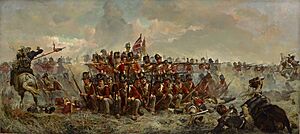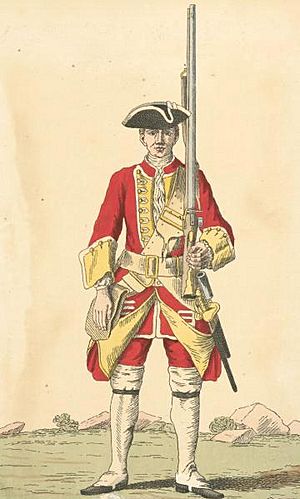28th (North Gloucestershire) Regiment of Foot facts for kids
Quick facts for kids 28th (North Gloucestershire) Regiment of Foot |
|
|---|---|
| Active | 1694 – 1 July 1881 |
| Allegiance | |
| Branch | |
| Type | Line Infantry |
| Size | One battalion |
| Garrison/HQ | Horfield Barracks, Bristol |
| Nickname(s) | The Old Braggs The Slashers The Silver Tailed Dandies |
| Engagements | War of the Spanish Succession War of the Quadruple Alliance War of the Austrian Succession French Revolutionary Wars Napoleonic Wars Crimean War |
The 28th (North Gloucestershire) Regiment of Foot was a special group of soldiers in the British Army. They were a type of infantry (soldiers who fight on foot) called a "line regiment." This means they fought in long lines on the battlefield. The regiment was first formed in 1694. Later, in 1881, it joined with another regiment, the 61st (South Gloucestershire) Regiment of Foot, to create the Gloucestershire Regiment.
Contents
A Look Back: The Regiment's Story
Starting Out: Early Adventures
The 28th Regiment began on February 16, 1694. It was first called "Sir John Gibson's Regiment of Foot," named after its leader, Colonel Sir John Gibson. Their first mission was to protect the British colony of Newfoundland. However, many soldiers got sick or died because of the extremely cold weather. The regiment was temporarily stopped in 1697 but started up again in 1702 with the same colonel.
After reforming, the regiment went to Europe to fight in the War of the Spanish Succession. They fought in battles like Battle of Elixheim in 1705 and Battle of Ramillies in 1706. Later, they were sent to Spain, where they lost more than half their men at the Battle of Almansa in 1707. They also helped capture Vigo in 1719 during the War of the Quadruple Alliance.
Becoming the 28th: New Name, New Wars
In 1751, the regiment officially became known as the 28th Regiment of Foot. They fought in Flanders during the War of the Austrian Succession. During the Seven Years' War, they took part in important battles like the Battle of Louisburg in 1758 and the Battle of the Plains of Abraham in Quebec in 1759.
The regiment returned to North America in 1776 to fight in the American War of Independence. They were involved in the Battle of White Plains in 1776. They also fought in the West Indies, helping to take Saint Lucia in 1778. However, French forces captured them on Saint Kitts in 1782, and they were held until the war ended. In 1782, the regiment was renamed the 28th (North Gloucestershire) Regiment of Foot. This new name connected them to a specific area in England, Gloucestershire. They then returned to Europe to fight against revolutionary France in 1793 and later went back to the West Indies.
Facing Napoleon: A Unique Distinction
In 1801, the regiment joined a British force sent to Egypt to fight against Napoleon's army. On March 21, during the Battle of Alexandria, something amazing happened. French cavalry (soldiers on horseback) broke through the British lines and attacked the 28th Regiment from behind. Even though they were already fighting enemies in front, the soldiers were ordered to "Rear Rank, 28th! Right About Face!" This meant the back row of soldiers turned around, and they fought back-to-back. They successfully defended themselves from both directions!
To remember this incredible act, the regiment was allowed to wear a special badge on the back of their hats, as well as the front. This was a very rare honour in the British Army.
The regiment also fought in Denmark, taking part in the Battle of Copenhagen in 1807.
Fighting in Spain and France: The Peninsular War

In 1808, the 28th Regiment went to Portugal to fight in the Peninsular War against Napoleon's forces. They fought in the Battle of Corunna in 1809. A small part of the regiment also fought bravely at the Battle of Talavera in 1809.
The regiment returned to the Peninsula in 1810. They saw action in many important battles, including:
- Battle of Barrosa (1811)
- Battle of Albuera (1811)
- Battle of Vitoria (1813)
- Battle of the Pyrenees (1813)
They then followed the French army into France, fighting at Battle of Nivelle (1813), Battle of the Nive (1813), Battle of Orthez (1814), and Battle of Toulouse (1814).
Waterloo and Beyond
The 28th Regiment was one of the few experienced regiments available for the Hundred Days campaign, which was Napoleon's final attempt to regain power. They fought bravely at the Battle of Quatre Bras and the famous Battle of Waterloo in June 1815. Because of their actions in these battles, the Duke of Wellington, the famous British commander, praised them highly.
The Victorian Era: Final Years
After the Napoleonic Wars, the regiment spent about 20 years in places like the Mediterranean, Ireland, and England. They were then sent to Australia as garrison troops, meaning they were stationed there to protect the area. From 1842 to 1848, they served in India.
The regiment also played a role in the Crimean War. They fought in major battles such as the Battle of Alma in 1854, the Battle of Inkerman in 1854, and the Siege of Sevastopol during the winter of 1854. They returned to India from 1858 to 1865 and then spent more time in the Mediterranean.
In the 1870s, changes were made to the British Army. The 28th Regiment was linked with the 61st (South Gloucestershire) Regiment of Foot. They shared a training base and recruiting area in Bristol. Their final postings were to places like Hong Kong, Singapore, and Penang.
On July 1, 1881, the 28th (North Gloucestershire) Regiment of Foot officially joined with the 61st Regiment to form the new Gloucestershire Regiment. This marked the end of the 28th Regiment as a separate unit.
Images for kids



